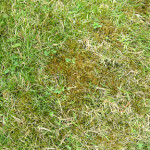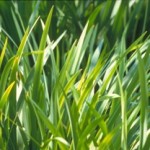Probably the biggest headache in the garden, moss thrives in the vast majority of untreated lawns. Wet Autumns and cold Winters are exacerbating the problem. Most gardeners will have trouble at some stage with moss on lawns. This is unsightly and is often a result of poor growing conditions.
 Moss can be a temporary problem following drought or water-logging, or more persistent, suggesting a problem with underlying conditions. On new lawns this may be due to poor site preparation. On established lawns poor vigor, acidic soil conditions, a lack of feed, insufficient aeration, poor drainage, shade, close mowing and over-use are likely to blame.
Moss can be a temporary problem following drought or water-logging, or more persistent, suggesting a problem with underlying conditions. On new lawns this may be due to poor site preparation. On established lawns poor vigor, acidic soil conditions, a lack of feed, insufficient aeration, poor drainage, shade, close mowing and over-use are likely to blame.
Raking is the preferred method for removing moss. For small lawns a wire ‘spring bok’ or fan rake will do but it’s much easier with a hand pulled rolling lawn scarifier. For larger lawns a powered lawn raker or scarifier with wire tines would be best.
Once raked, Apply your preferred iron sulphate based moss killer to the moss that remains. It should penetrate deeply into the moss now that you’ve thinned it with your raking. This is one of the best ways of reducing moss infestation.
 After any invasive treatment you should always assist the lawn to recover. This is easier if you’ve been wise with your timing and nature is helping by providing some warmth, sun and rain to speed things along. Get some fertiliser into the lawn. I always use a fertiliser containing potassium as this helps the grass fight off the stress of the raking and will help protect against disease.
After any invasive treatment you should always assist the lawn to recover. This is easier if you’ve been wise with your timing and nature is helping by providing some warmth, sun and rain to speed things along. Get some fertiliser into the lawn. I always use a fertiliser containing potassium as this helps the grass fight off the stress of the raking and will help protect against disease.
Of course you need to remember, like most weeds the presence of moss is usually an indicator of a larger problem. Unless the underlying issue is addressed (shade, poor drainage etc), the presence of moss will likely be a recurring headache.

